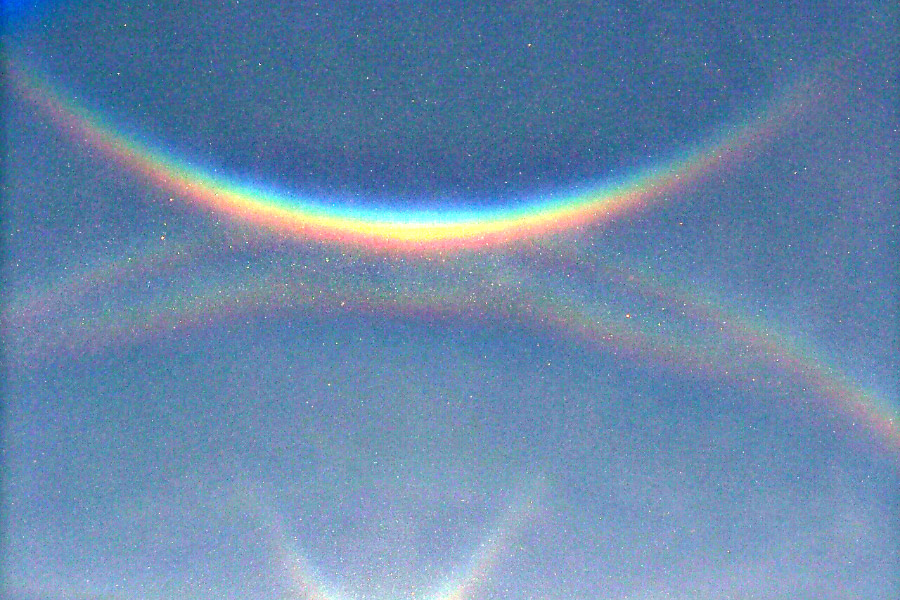Description
For each appearance of the 46° contact arcs, there are different light paths.

Crystal type:
- Plate crystals
- rotating
- Refraction at side and base surface
- very rare


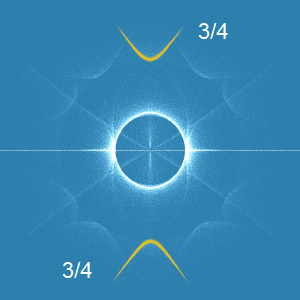
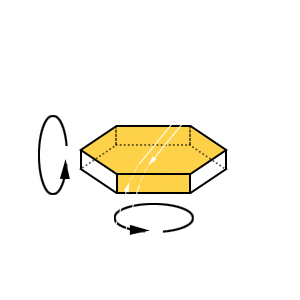
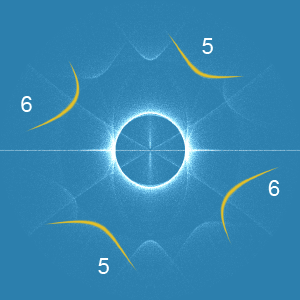
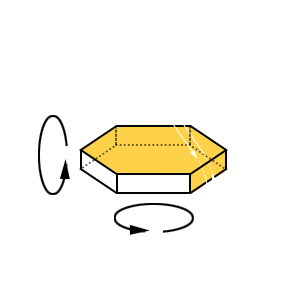
The system of 46° contact arcs consists of up to 10 arcs and has an extensive appearance. The 46° contact arcs are also referred to as 46° Lowitz arcs, as their formation is similar to that of Lowitz arcs.
The upper and lower middle 46° contact arcs (EE52A/EE52B) can be compared with the upper and lower contact arcs on the 22° ring. Both arcs open up with increasing solar altitude and form a fully inscribed circle from a solar altitude of about 65°. This resembles the inscribed halo.
At a solar altitude of up to 20°, 4 more contact arcs can be observed near the circumzenithal arc. The two upper outer 46° contact arcs (EE52C/EE52D) open up with increasing solar altitude, move down along the 46° ring and touch each other from a solar altitude of about 65°. The two upper inner contact arcs (EE52E/EE52F) move towards the circumzenithal arc with increasing solar altitude and connect from a solar altitude of about 15° with the encircling 46° contact arcs (EE52E with EE52J and EE52F with EE52I).
At the lower part of the complex system, there are 4 more contact arcs. The two lower outer contact arcs (EE52G/EE52H) move down along the 46° ring with increasing solar altitude. The two encircling contact arcs (EE52I/EE52J) move up with increasing solar altitude and connect from a solar altitude of about 15° with the upper inner contact arcs (EE52E with EE52J and EE52F with EE52I).
To date, there are only very few observations of this halo type. One of the most famous observations was made in Finland. In Germany, the 46° contact arcs were first detected on 01.11.2014 in the great halo phenomenon of Miesbach.
Simulation
Betätige den Slider, um die Sonnenhöhe zu ändern.
Betätige den Slider, um die Sonnenhöhe zu ändern.
- EE52A - Upper middle 46° contact arc
- EE52B - Lower middle 46° contact arc
- EE52C/EE52D - Left/Right upper outer 46° contact arc
- EE52E/EE52F - Left/Right upper inner 46° contact arc
- EE52G/EE52H - Left/Right lower outer 46° contact arc
- EE52I/EE52J - Left/Right encircling 46° contact arc
Origin
The 46° contact arcs are formed by refraction at the 90° edges of Lowitz-oriented crystals. The 90° refraction corresponds to the entrance of light rays through a top face of the crystal and the exit through a side face (or vice versa). According to Greenler, "Lowitz orientation" generally refers to a full 360° rotation of a plate crystal around a horizontal axis. However, limited pendulum movements of the plates or Parry-oriented column crystals swinging around their long axis have also been discussed as possible Lowitz orientations.
According to the theory, there are 6 possible light paths for the 46° contact arcs, with paths 3 and 4 contributing to the same arcs due to symmetry reasons (see illustration above). This effectively leaves 5 different light paths, each of which can produce a maximum of 2 different contact arcs. This results in a maximum number of 10 contact arcs, which are, for example, visible in simulations for a 0° solar altitude above and below the horizon.


